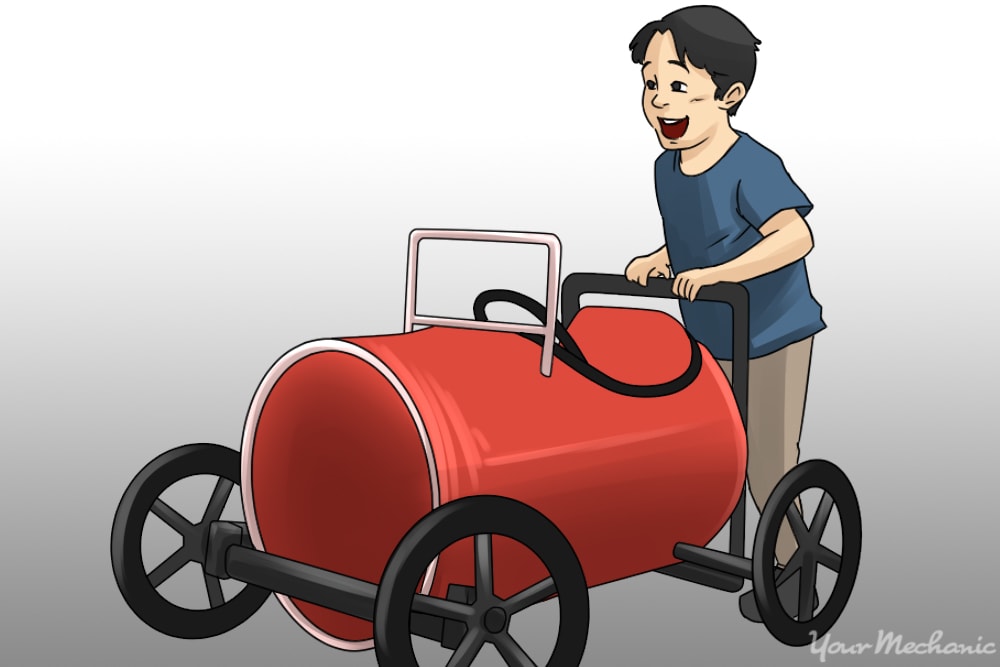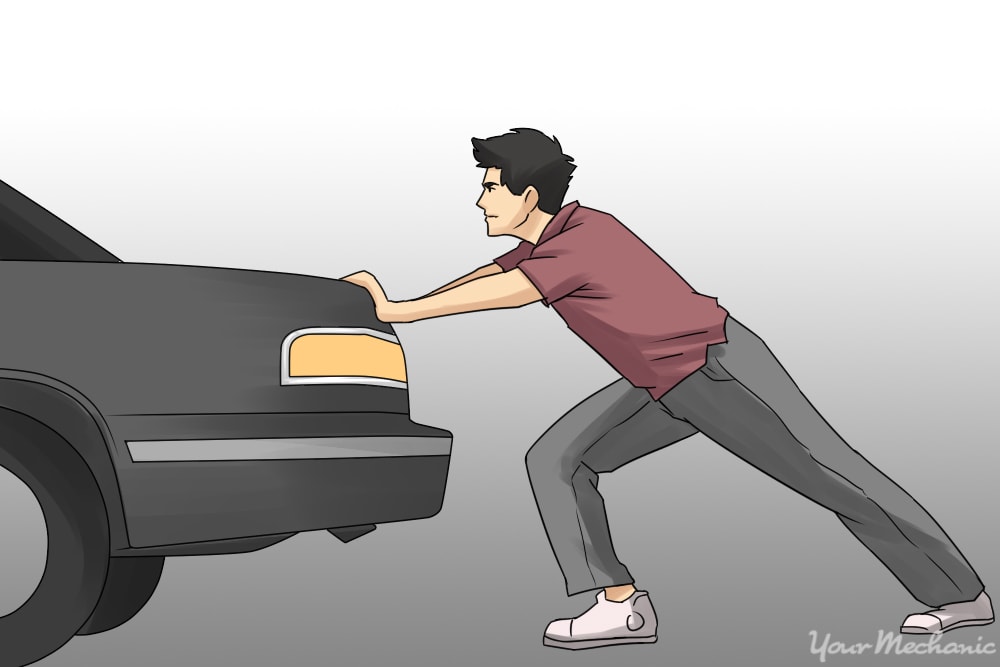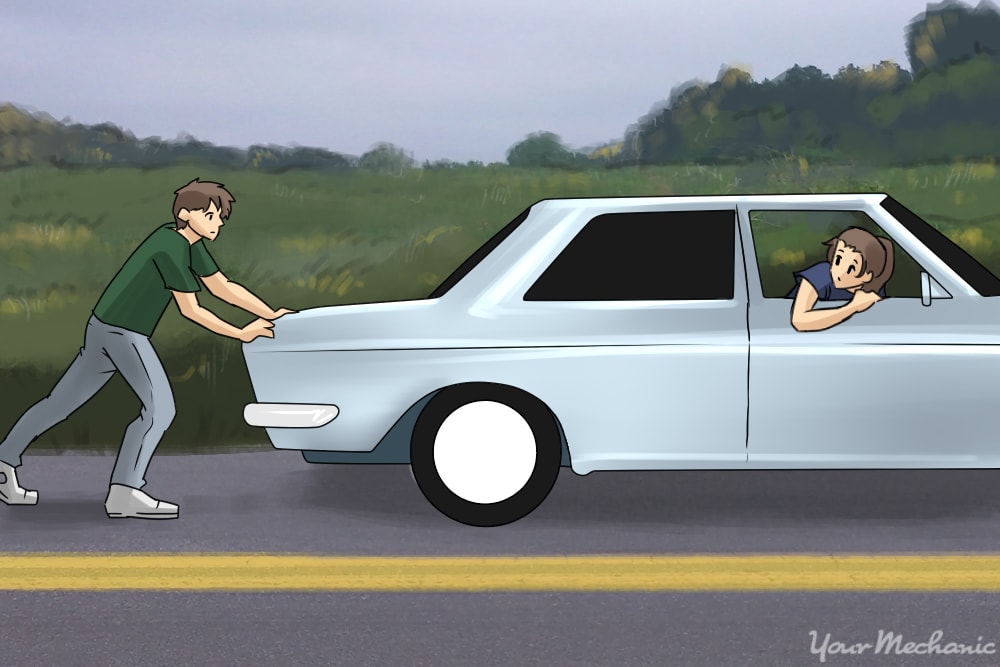

When your car is operating properly, it’s easy to take it for granted that it will start whenever you turn the key. When it doesn't start properly, it can be frustrating and confusing.
Push starting (also known as pop starting, bump starting, crash starting, or popping the clutch) a vehicle with manual transmission should be the last resort when you can’t get it started, especially when a normal key-turn ignition fails and then jump starting fails after that. Basically, push starting a vehicle forces the engine to start forcing the engine to rotate and fire.
But since the transmission types between manual and automatic are much different, it is much more difficult to get the internal moving parts of the gearbox rotating in an automatic transmission, and it could potentially cause damage to the transmission. That said, trying to push start a vehicle with automatic transmission is not recommended.
- Warning: Do not attempt to push start a vehicle alone in any situation. An attempt to do so is not only dangerous for your vehicle, but also the likelihood of injury is high, and there is potential that it could be fatal. As long as you have a few friends or family members to help, follow the instructions below to learn how to push start a vehicle.
When you car doesn’t start, there can be several things at fault, including:
- A blown ignition fuse
- A bad battery
- A damaged starter motor
- A discharged battery as a result of leaving the lights on
- A faulty ignition switch
- A poorly operating starter
Whatever be the cause, it is possible to push start a vehicle equipped with a manual transmission even if you don’t have access to a set of booster cables.
A manual transmission is designed like a direct drive system: the engine usually propels the vehicle by turning the transmission, but once it’s already in motion, a manual transmission can keep the engine running because of its momentum.
When you press down the clutch pedal, the transmission is disengaged from the flywheel on the back of the engine and it “freewheels.” The engine can rev but the vehicle will not be propelled forward in gear.
When you release the clutch pedal, the clutch engages with the flywheel on the engine’s crankshaft and the transmission input turns at the same speed as the engine.
Whenever you start your car, the starter motor turns the flywheel to begin the combustion process inside the engine. By push starting a car, you essentially use the vehicle’s momentum to act in the same fashion as the starter motor.
Method 1 of 3: Push start your car down an incline
This method is the most reliable way of “push-starting” a car. In this method, you are able to start the car on your own which is great if you are all by yourself. Unfortunately, your car may not have stopped in the right location or position for this option to work.
Step 1: Turn on the ignition. Sit in the driver’s seat and turn on the ignition.
If the ignition is not on and the clutch is engaged, the car will roll and the engine will turn over without starting as there is no fuel being delivered to the engine from the car’s fuel pump.
Step 2: Release the parking brake. If your car stopped on an incline, you may have engaged the parking brake, put the transmission in gear or done both. Apply your foot to the brake pedal and release the parking brake.
- Note: Don’t release the parking brake until you have your brake pedal pressed firmly. Since your engine isn’t running currently, the power brakes are not activated and you will need to exert much more pressure to activate the brakes.
Step 3: Put your car into second gear. Put your manual transmission’s gearshift lever into second gear.
You can perform this process using other gears as well, but when you release the clutch later on, second gear will give you the smoothest possible performance.
- Tip: Push starting a car in second gear allows you to start it smoothly and without a big jolt. This in turn reduces the wear on the clutch and transmission. Use first gear only if you have a short distance to push start the car or if you can’t push your car a considerable distance.
Step 4: Press the clutch pedal all the way in. At this point, the only thing holding your vehicle stationary is your brake pedal, so maintain firm pressure on the brake until you are ready to attempt a push start.
Step 5: Release the brake pedal. Since your car is on an incline, it will begin to roll down the slope when you release the brake pedal.
- Note: Your primary concern is to maintain safe control of your vehicle, so pay attention for traffic and pedestrians.
Step 6: Release the clutch. As your car rolls down the hill gaining speed, slowly release the clutch pedal.
You will feel the engine start to “chug” and you will feel resistance trying to slow you down. After a few seconds, your engine should come to life.
Step 7: Press the clutch pedal in to coast. If the engine has started, it will remain running even with the clutch pedal pressed in.
You can now continue driving your car as normal, but don’t shut the engine off until you reach your destination.
Method 2 of 3: Push start your car with assistance
If you can get your family or some friends to help you, you’ll be able to use their assistance to push start your car even on a flat road surface.
- Warning: Push-starting a car by human power is dangerous as your helpers may need to walk or run behind your car in the midst of traffic. Always wait for a safe situation to begin the push start process.
Step 1: Position your helpers. Ask your helpers to stand behind your vehicle to push start it. Ideally, you will need three or four adults to push your car, though one or two strong adults can make it work in most instances.
Step 2: Release the parking brake. Sit in the driver’s seat and turn on the ignition. Press the brake pedal firmly and release the parking brake.
Step 3: Prepare to push start the vehicle. Put your car into second gear and press the clutch pedal in all the way. The only thing keeping your car in place is your brake pedal, so ensure that you press it down firmly.
Step 4: Communicate with your helpers. Let them know that you are ready to begin the process of push starting your car.
Warning: Ensure that the way is clear before your begin the process of push starting your car.
Tip: Count down from three so that all your helpers start pushing at the same time.
Step 5: Release the brake pedal as they start pushing. While your vehicle slowly gains speed from the people pushing your vehicle, release the brake pedal while holding down the clutch pedal completely.
- Note: Don’t touch the brakes as your helpers can hurt themselves by running into your car.
Step 6: Slowly release the clutch. Release the clutch pedal slowly once you’ve reached speeds of roughly 5 miles per hour.
- Warning: Warn your helpers just before you release the clutch pedal so they don’t run into the car abruptly. If you take them by surprise, they may fall down or injure their wrists while pushing your car.
As you release the clutch, the engine will begin to turn over and start. Press the clutch pedal in, and if the engine has started, it will stay running.
If the engine doesn’t start the first time, give your friends a chance to rest, then try again.
Method 3 of 3: Push start your car by yourself
- Warning: Though this method can be used to push start your car, it should only be used as a last resort. You run the risk of losing control of your vehicle while hurting yourself in the process.
Step 1: Ensure that your vehicle is on a flat surface. Confirm that your vehicle is parked on a flat surface with several hundred yards of free space in front of it.
- Warning: If your vehicle is not on a level surface, do not attempt this method at all. If there are vehicles parked nearby or if your car stopped in a tight space, do not try to push start the car by yourself.
Step 2: Turn your on the ignition. Put your transmission gear shift in the neutral position and disengage your parking brake.
Your vehicle will now able to roll freely. Be prepared to jump in the driver’s seat and engage the parking brake once the engine starts.
Step 3: Leave the driver’s side door open. Familiarize yourself with the exact location of the clutch pedal, the brake pedal, and the parking brake.
Confirm that you have access to the steering wheel to quickly correct the direction in which your car is moving, if needed.
Step 4: Push your car. Begin pushing your car from the windshield pillar. Use the front pillar of the driver’s door for support but put all your effort into pushing on the windshield pillar, or A pillar.
If your vehicle begins to roll, continue to push until you reach a slow jog.
- Note: If your vehicle doesn’t move with your effort, call a tow truck or wait for help rather than injuring yourself.
Step 5: Get into the car. In a swift motion, hop into the driver’s seat. Hold on to the driver’s side pillar with your left hand for support, and swing your body into the driver’s seat with your right leg entering the car first.
Alternately, try to sit down quickly and then swing your feet into the car.
Step 6: Apply second gear. In a smooth motion, press the clutch pedal in, engage the gear shift into second gear, then release the clutch pedal.
- Note: This needs to happen within 1-2 seconds of getting into the driver’s seat. Practice it before you start pushing if necessary.
When you release the clutch pedal, the engine will begin to turn over and will start.
Press the clutch pedal in immediately to keep it running or press the accelerator to start driving forward if you are in a safe location.
Unfortunately, if the engine doesn’t start, you may need to repeat the process from the beginning.
When you push your car to get some momentum and engage the transmission, the engine will start spinning. If your car has a manual transmission and the battery is dead, you can use any of these methods to get it to start.
If the engine still doesn’t start after pushing your car or if you hear loud noises when you start the car, get a certified mechanic, such as one from YourMechanic, to inspect the car and check if the starter needs to be replaced.





